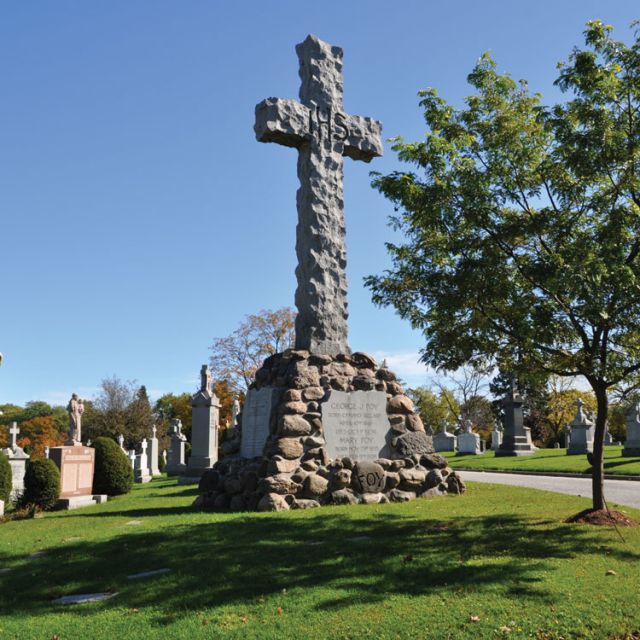“Mount Hope Cemetery is unique because it provides examples of how memorialization has changed over time. Mount Hope represents three centuries of lives lived,” said Amy Profenna, manager of marketing and public relations with Catholic Cemeteries — Archdiocese of Toronto.
“Monuments present different meanings for each of us. They tell a story and they offer important information about history, religious views, societal relationships and the like.”
In this unique Catholic burial ground, opened in 1900, lay and religious order Catholics have been put to rest with a variety of monuments made from stone and metal. The years 1880 to 1900 mark the beginning of the Iron Age for Catholic Cemeteries, where monuments, like the crosses that mark the graves of the Loretto Sisters, were cast in iron. But stern-looking iron soon fell out of fashion, making way for marble.
Marble became the most prominent stone, perhaps because of its ability to be hand-carved with great detail. Angels, in white marble, still beam on a sunny day at Mount Hope. But this stone is soft, making it vulnerable to acid rain and general deterioration. It gets dirty easily and does not age well. Many marble markers at Mount Hope have degraded to the point that they have become too dangerous to stand upright, and now, as is law, must lie flush with the turf. No new marble monuments are purchased through Catholic Cemeteries.
These days, granite is the stone of choice. It sparkles a little in the sunlight and comes in two finishes: polished and a rugged steel granite. This stone comes from around the globe, with different quarries producing different colour granite.
“A memorial keeps remembrance alive, it commemorates and it helps the surviving loved ones cope with loss. Whatever memorial a family chooses it has great significance for the survivors of the deceased,” Profenna said.
In the past, monuments had no height restriction, which is evident by some of the pillars and statues that still tower at Mount Hope. As long as a family could afford the monument, it could stand as a memorial to their beloved decease. Take for instance the George Foy monument. Foy, for 40 years, was a liquor and tobacco merchant. A single piece of granite, the Foy monument stands at 12 metres and may be the largest private family monument in Ontario.
Modern monuments can have a maximum height of about 1.5 metres, but “monuments greater than this size which would add to the decorum and the beauty of the cemetery may be considered at our discretion,” said Profenna.
“Mount Hope illustrates how monuments have changed over the last 100-plus years in terms of materials, craftsmanship, lettering styles, etc.,” said Profenna. “Also, the history of the monuments, like the Foy monument, is interesting. It took a team of 24 horses to transport this giant (12-metre)-high cross from Union Station to the cemetery. Even the presence of this monument is impressive, how it towers above all the other monuments near it. It can be seen from every angle in the cemetery.”
Today there are bylaws ruling what monument design families can choose. And for Catholic cemeteries, they must contain a religious symbol, like a Celtic cross or Latin cross, doves, lambs, lilies and angels. Families can also request unique and personalized designs.
Mount Hope, in the 1960s and ’70s, would see up to 4,000 burials a year but now sees about 1,200. Cremations are more popular now, and are permitted as long as the service is done according to Catholic teaching and involves liturgy, Mass and a committal.
“Whatever memorial a family chooses, it has great significance for the survivors of the deceased,” Profenna said.


